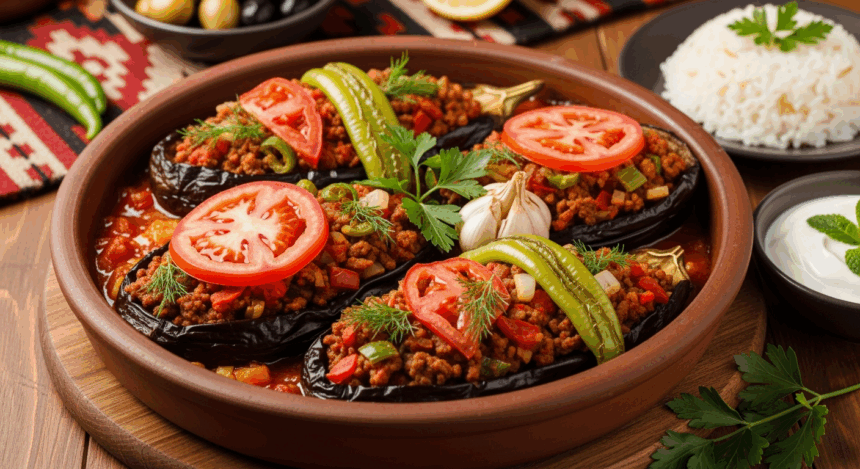Ah, Turkish eggplant casserole—or as I like to call it, “the dish that makes people think you spent way more time in the kitchen than you actually did.” If you’ve got some eggplants sitting in your fridge giving you the guilt-eye every time you reach for takeout instead, this recipe is about to become your new best friend. It’s that perfect blend of “looks impressive” and “surprisingly easy” that we’re all constantly searching for in life.
Why This Recipe is Awesome
Let me count the ways! First off, this Turkish eggplant casserole (known as “Imam Bayildi” in Turkey, which hilariously translates to “the imam fainted”—supposedly because it was SO delicious) is basically impossible to mess up. You can literally burn the eggplant a little and people will think you meant to add “smoky notes.” That’s culinary magic right there.
Second, it’s one of those dishes that tastes even better the next day, which means you can make it ahead and pretend you just whipped it up when friends come over. And finally, it’s vegetarian but so hearty that even your “where’s the meat?” friends won’t complain. Trust me on this one.
Ingredients You’ll Need
• 4 medium eggplants (the ones that don’t look like they’ve had a rough life in the produce section)
• 4 large tomatoes, diced (or one can of diced tomatoes if you’re feeling lazy—no judgment here)
• 2 onions, sliced (prepare for tears, emotional and literal)
• 4-5 cloves of garlic, minced (vampires beware!)
• 3 tablespoons olive oil (the good stuff, not the one that’s been sitting in your pantry since 2019)
• 2 tablespoons tomato paste (the secret weapon of Mediterranean cooking)
• 1 teaspoon sugar (to balance that tomato acidity—chemistry, baby!)
• 1 handful of fresh parsley, chopped (or dried if fresh herbs are outside your current life budget)
• Salt and pepper to taste (duh)
• Optional: 1 teaspoon of red pepper flakes (for those who like their food to bite back)
Step-by-Step Instructions
1. Prep your eggplants. Cut them in half lengthwise and score the flesh in a diamond pattern without piercing the skin. This isn’t just for looks—it helps them cook evenly and absorb all that saucy goodness.
2. Salt therapy time. Sprinkle salt over the cut sides of your eggplants and let them sit for about 30 minutes. This draws out the bitter juices and prevents the eggplant from soaking up oil like it’s going out of style. You’ll see little beads of moisture forming—that’s success!
3. Pre-heat your oven to 375°F (190°C). While that’s happening, rinse your eggplants and pat them dry with paper towels. They’ve had their cry, now it’s time to cook.
4. Get those eggplants roasting. Brush them with olive oil, place them cut-side down on a baking sheet, and pop them in the oven for about 20 minutes until they start to soften and get those gorgeous brown edges.
5. Meanwhile, tomato sauce magic. Heat the remaining olive oil in a large skillet over medium heat. Add those sliced onions and cook until they’re translucent and starting to caramelize (about 5-7 minutes). Add garlic and cook for another minute—just until your kitchen smells like heaven.
6. Add your tomatoes, tomato paste, sugar, and red pepper flakes (if using). Stir well and let it simmer for about 10 minutes until it thickens slightly and smells like an Italian grandmother’s kitchen. Season with salt and pepper.
7. Assembly time! Take your partially roasted eggplants out of the oven and flip them over. Spoon your tomato sauce generously over each eggplant half, letting it seep into those score marks you made earlier.
8. Final bake. Return the eggplants to the oven and bake for another 20-25 minutes until everything is bubbly, the eggplants are completely tender, and your house smells amazing.
9. Garnish and serve. Sprinkle with fresh parsley before serving, either hot or at room temperature. Both are delicious, though room temp lets the flavors really shine (and is traditional in Turkey).
Common Mistakes to Avoid
Skipping the salting step. I know it seems fussy and you’re thinking “but I’m HUNGRY NOW,” but this prevents your dish from becoming an oil slick with bitter undertones. Take the 30 minutes—scroll through TikTok or something.
Undercooking the eggplants. Nobody, and I mean NOBODY, enjoys crunchy eggplant. It should be meltingly tender when you stick a fork in it. If it resists, keep cooking.
Going light on the olive oil. This isn’t the time for your health kick. Eggplant needs fat to taste good—that’s just science. You can do extra cardio tomorrow.
Forgetting the sugar in the tomato sauce. It’s just a teaspoon but makes all the difference between “meh” and “wow” when balancing tomato acidity. Don’t be a hero; use the sugar.
Alternatives & Substitutions
No fresh tomatoes? A 14 oz can of diced tomatoes works perfectly fine. Sometimes better, TBH, especially if tomatoes aren’t in season.
Watching your carbs? Skip the sugar and add a tiny splash of balsamic vinegar to the sauce instead. Different but delicious.
Want more protein? Crumble some feta cheese on top before the final bake. Not traditional, but who’s going to report you to the Turkish food police?
Hate parsley? Fresh mint or dill make fantastic alternatives and keep within the Mediterranean flavor profile. Or just skip it—I’m not here to police your herb choices.
Vegetable variations: You can add diced zucchini or bell peppers to the sauce if you want to clean out your veggie drawer. The dish is very forgiving.
FAQ (Frequently Asked Questions)
Can I make this ahead of time?
Not only can you, but you probably should! This dish actually tastes better the next day when all the flavors have had a chance to get cozy with each other. Make it up to two days in advance and reheat gently in the oven.
Is this dish served hot or cold?
Yes! (Sorry, couldn’t resist.) Traditionally in Turkey, it’s often served at room temperature or even cold, but it’s equally delicious hot. Room temp is great for summer; hot works better in winter. Follow your heart.
Can I freeze this?
You can, but the texture of the eggplant might change slightly when thawed. If you do freeze it, thaw completely in the fridge overnight before reheating. But honestly, it rarely lasts long enough to need freezing.
My eggplants look ugly. Did I mess up?
Nope! Eggplant casseroles aren’t winning any beauty contests. They’re supposed to look slightly collapsed and maybe a little mushy. It’s all about the flavor, not Instagram aesthetics.
What should I serve with this?
A simple rice pilaf is traditional. Or go carb-happy with some crusty bread to soak up all that sauce. A crisp green salad on the side adds nice textural contrast to all that tender eggplanty goodness.
My family hates eggplant. How do I trick them into eating this?
First, get better family members. Kidding! Call it “Mediterranean vegetable casserole” instead of mentioning eggplant specifically. Also, make sure you cook the eggplant until properly tender—most eggplant-haters have only had badly cooked, bitter eggplant.
Final Thoughts
Congratulations! You’ve just mastered a dish that’s been making people faint (allegedly) for centuries. This Turkish eggplant casserole isn’t just delicious—it’s also your ticket to looking like you know what you’re doing in the kitchen with minimal actual effort.
The best part? It works for practically any occasion. Casual dinner? Yes. Impressing a date? Absolutely. Pretending you’ve embraced a sophisticated Mediterranean lifestyle while actually just using up vegetables before they go bad? That’s literally why I made it yesterday.
So go forth and eggplant! And remember, if anyone asks for your secret, just smile mysteriously and say it’s an old family recipe passed down for generations. Your great-grandmother from Izmir will forgive you. Probably.



